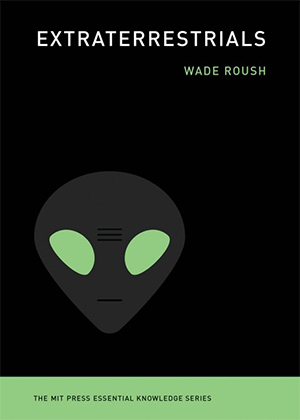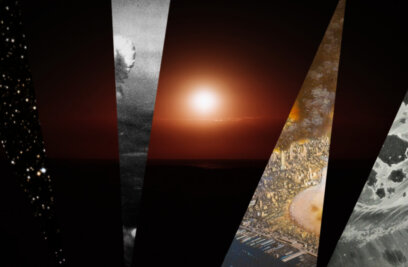Alien Dreams: The Surprisingly Long History of Speculation About Extraterrestrials

To feel small, all we have to do is look up. The sun, the Moon, the stars, the planets, and the Milky Way are evidence enough that Earth is not all that is. And for as long as humans have had words, we have been sharing stories about the presumed builders and occupiers of those vaulted heavens: the gods, spirits, angels, and demons who were, in a sense, the first extraterrestrials.
According to a Cherokee story, for example, the Milky Way is a great web spun across the sky by Grandmother Spider, who used it to reach the other side of the world and bring back the sun. In one grisly Aztec myth, the war god Huitzilopochtli sprang from his mother Coatlicue’s womb fully grown and fully armored. He beheaded his sister, Coyolxauhqui, who had been plotting to kill Coatlicue, and cast her head into the sky, creating the Moon.
Materialist interpretations of the cosmos eventually began to take the place of mythological ones. But the idea that there might be other beings in the sky has stayed with us, and it found its first protoscientific roots in Greece in the sixth century BCE.
Anaximander, a philosopher who lived in Miletus in modern-day Turkey, contributed one key idea. He was the first to propose that Earth is a body floating in an infinite void, held up by nothing. For someone who lived 2,200 years before Isaac Newton, this was a stunning insight. The philosopher Karl Popper called it “one of the boldest, most revolutionary, and most portentous ideas in the whole history of human thought.” Anaximander also thought Earth was a cylinder with the continents arrayed on one flat end, so he wasn’t right about everything. But he did invent the idea of space, a place with no absolute up or down. And just as important, Anaximander’s system was the first to leave open the possibility that there are other worlds like ours. (Though, to be clear, he may not have believed that these worlds existed elsewhere in space. He may have thought they preceded or would succeed Earth in time or perhaps coexisted in some parallel universe.)
Anaximander was the first to propose that Earth is a body floating in an infinite void, held up by nothing.
Anaximander’s successors were more definite about the idea that came to be known as “the plurality of worlds” and more willing to explore its implications. In the fifth century BCE, the Thracian philosopher Leucippus and his pupil Democritus invented atomism: the belief that the visible universe consists of tiny, indivisible, indestructible atoms, churning in the void without purpose or cause. In this picture, worlds aren’t divinely created; they simply form when enough atoms collide and stick together. Democritus thought that there was an infinite supply of atoms, so he reasoned that there must be an infinite number of worlds. His pupil Metrodorus of Chios put it this way: “It seems absurd, that in a large field only one stalk should grow, and that in an infinite space only one world exist.”

And then there’s Epicurus. He lived about a century after Democritus and is most notorious for his philosophy that pleasure — best obtained through modest, self-sufficient living — is the greatest good. But Epicurus read Democritus and thoroughly absorbed his empiricist, atomist worldview, including the idea that there must be many worlds. “There is an unlimited number of cosmoi [worlds], and some are similar to this one and some are dissimilar,” Epicurus wrote in a letter to the historian Herodotus.
Epicurus’s ideas are important not just because they were prescient but because they became a long-lasting irritant for future philosophers and theologians. Unfortunately, most of his writings are lost. What we know about his thought comes mainly from “De rerum natura,” or “On the Nature of Things,” a book-length poem by his Roman disciple Lucretius.
You can think of this book, written around 50 BCE, as the first volume of popular science. Here’s what Lucretius said about the Epicurean view of other worlds:
If store of seeds there is
So great that not whole life-times of the living
Can count the tale …
And if their force and nature abide the same,
Able to throw the seeds of things together
Into their places, even as here are thrown
The seeds together in this world of ours,
’Tmust be confessed in other realms there are
Still other worlds, still other breeds of men,
And other generations of the wild.
The passage is a milestone in discussions of extraterrestrials. It goes beyond the basic idea that an infinity must contain many worlds to offer what is probably the first straightforward assertion in Western literature that aliens must exist.
The first and sadly the last for a very long time.
The truth is that the mechanistic, nonsupernatural picture of the world offered by Anaximander, Democritus, and Epicurus was radical for its day. It failed to gain a large following in ancient Greece. In Athens in 450 BCE, the philosopher Anaxagoras posited that the sun is a fiery rock and that the Moon is an Earthlike body that glows in the sun’s reflected light. He was promptly arrested on charges of impiety and sentenced to death. After his friend and former pupil Pericles came to his defense, he was released but banished.
Both Plato (428–348 BCE) and Aristotle (384–322 BCE) lambasted Democritus’s idea of a plurality of worlds on theological grounds. Plato, a monotheist, argued that there is only one creator and that therefore there can be only one world, “if the created copy is to accord with the original.” Aristotle similarly thought that a plurality of worlds would require a plurality of Prime Movers to keep them in motion — a plainly heretical idea. The idea of infinite worlds also conflicted with his view of physics, in which the five basic elements — earth, air, fire, water, and divine aether — tend to move up or down toward their “natural places” at the center or the edges of the universe. Because things made of earth always sink to the center, Aristotle believed, Earth must be the only world, and there can be no solid bodies in the heavens.
Though Aristotle was a pagan, his anthropocentric picture of the universe was a gift to early Christian theologians. The Book of Genesis, which says God purposefully created the heavens and the earth, left no room for other worlds or other sentient beings (unless you count angels and demons). The New Testament then introduced the idea that God was incarnated as Christ to rescue the faithful from sin and damnation — a flattering story implying that humans are uniquely worthy of Christ’s sacrifice. As the scientist and Christian apologist William Whewell would later put it, the Incarnation made Earth into “the Stage of the Great Drama of God’s Mercy and Man’s Salvation.”
“Small wonder the early Christians tossed the Epicurean package, extraterrestrials and all, into the abyss of doctrinal errors,” writes the Catholic ethicist Benjamin Wiker.
By contrast, Democritus, Epicurus, and Lucretius offered a picture of a purely mechanical universe where everything arises from the purposeless collisions of atoms and where humans might be just one of an infinite number of intelligent races. “Small wonder the early Christians tossed the Epicurean package, extraterrestrials and all, into the abyss of doctrinal errors,” writes the Catholic ethicist Benjamin Wiker.
As Christianity swept across the decaying Roman Empire in the third and fourth centuries CE, the Church Fathers ridiculed and suppressed the Epicureans and their ideas and allowed their writings to burn or crumble. Atomism, the pursuit of pleasure, the plurality-of-worlds idea — all of it slipped into darkness, where, as Wiker observes, “it stayed for nearly a thousand years.”
Nudged Aside
Somehow, though, Lucretius’s poem “On the Nature of Things” managed to cross the abyss into the 15th century. “The Swerve,” a delightful book about “how the world became modern” by the Harvard literary scholar Stephen Greenblatt, tells the story of the Florentine book collector Poggio Bracciolini, who recovered a copy of the poem in the library of a monastery in southern Germany in 1417. Within 60 years, hundreds of manuscripts and print editions were in circulation, reigniting interest in Epicureanism. Greenblatt argues that the poem’s atheistic and materialist ideas helped usher in Renaissance humanism — an inquisitive philosophy that, despite its name, began to question humanity’s privileged station in the cosmos.
Whether the credit is due to Bracciolini or not, the Renaissance saw steadily growing interest in the idea of the plurality of worlds and its corollary, the possibility that other worlds might be populated by other beings. Mikołaj Kopernik, better known as Nicolaus Copernicus, provided one key stepping stone.
The Polish mathematician and astronomer was born in 1473 — coincidentally, the same year the first print edition of “On the Nature of Things” appeared. (Note the date here: Copernicus lived at the same time as Christopher Columbus, who was 22 years his senior; Leonardo da Vinci, who was 21 years older; Niccolò Machiavelli, four years older; and Martin Luther, 10 years younger.) Copernicus is central to the story of extraterrestrials not because he believed in them — the question didn’t seem to interest him — but because he was the first person to propose, based on observation and calculation, that Earth was not the center of the visible universe.
Around 1510, Copernicus began writing the commentaries and manuscripts that would become “De revolutionibus orbium coelestium” (“On the Revolution of the Celestial Spheres”). Finally published in 1543, the year Copernicus died, the book upended the old Aristotelian system. It argued that Earth rotates around its pole, that the Moon orbits Earth, and that Mercury, Venus, the Earth–Moon system, Mars, Jupiter, and Saturn all travel around the sun at their own rates. Finally, it asserted that the firmament — the outermost celestial sphere, containing the stars — must be incomprehensibly far away, at least compared to the distances between the sun and the planets.
Copernicus’s heliocentric model accounted for important oddities that the old Aristotelian system couldn’t adequately explain, such as the occasional “retrograde” or backward motion of the other planets against the background stars. But, of course, heliocentrism wasn’t immediately accepted, not least because it amounted to a huge demotion for Earth. It left us with only a single heavenly attendant, the Moon, and it forced Copernicus’s readers to reckon with the idea that we live on a planet that is just like any other. This premise — that there’s nothing particularly special about Earth and that we aren’t in a privileged, central position to observe the universe — would come to be known as the Copernican principle, and it’s at the core of the modern-day case for doing research related to the search for extraterrestrial life (SETI).
Any planet important enough to have moons, Kepler supposed, must also have people.
Copernicus knew his theory would provoke religious objections, which may be why he declined to publish it during his lifetime. His follower Giordano Bruno was not so cautious. Bruno was a Sicilian subject who entered the Dominican order in Naples and then became a religious vagabond. He read Lucretius and Copernicus, took their ideas deeply to heart, and made some startling leaps of his own.
In three sets of dialogues published between 1584 and 1591 — “La cena de le ceneri” (“The Ash Wednesday Supper”), “De l’infinito universo et modi” (“On the Infinite Universe and Worlds”), and “De immenso” (“Of vastness”) — Bruno argued that at least some of the stars are suns with their own planets and that some of these planets must have their own residents. On this and many other subjects, Bruno’s daring views conflicted with long-standing doctrines of the Catholic Church: For starters, that the universe was created for humanity alone and that there can be no people on other worlds without another Christ to redeem them. Bruno was arrested in Venice in 1592 on charges of blasphemy and heresy and sent to Rome, where his trial lasted seven years. On February 17, 1600, he was hanged naked upside down and burned at the stake.
Bruno’s persecution was widely followed by people living outside Rome, but it couldn’t prevent the emergence of a new understanding of the heavens. In 1609, Johannes Kepler, the German mathematician and astronomer, published “Astronomia nova” (“New Astronomy”), which extended Copernicanism in crucial ways. Understandably, Kepler was elated to receive a copy of Galileo Galilei’s “Siderius nuncius” (“Starry Messenger”) soon after it was published the following year. The book announced Galileo’s discovery of mountains on the Moon and four satellites orbiting Jupiter: we call them Io, Europa, Ganymede, and Callisto. These Jovian moons formed what was, in essence, a miniature solar system obeying the same rules as the planets. This discovery provided spectacular evidence for Copernicanism and in Kepler’s mind confirmed his own theories about planetary motion. But here’s the interesting part for our purposes: Even though Kepler (a Protestant) knew of Bruno’s travails and the Catholic Church’s attitude toward the plurality-of-worlds idea, he sent Galileo (a Catholic) a congratulatory letter that included speculation about extraterrestrials. Any planet important enough to have moons, Kepler supposed, must also have people. “These four little moons exist for Jupiter, not for us,” he wrote. “Each planet in turn, together with its occupants, is served by its own satellites. From this line of reasoning we deduce with the highest degree of probability that Jupiter is inhabited.”
Galileo cannily declined to endorse that idea. “The view of those who would put inhabitants on Jupiter, Venus, Saturn and the Moon, meaning by ‘inhabitants’ animals like ours, and men in particular” was “false and damnable,” he wrote in his pamphlet “Istoria e dimostrazioni intorno alle macchie solari” (“Letters on Sunspots”) in 1613. But while Galileo may have sidestepped Bruno’s error in this case, he eventually ran afoul of the church for different reasons. His volume “Dialogo sopra i due massimi sistemi del mondo” (“Dialogue Concerning the Two Chief World Systems”), a rousing defense of Copernicus, angered Pope Urban VIII and his inquisitors. In 1633, the church sentenced Galileo to a house arrest that lasted until his death in 1642.
So Many Earths
From Democritus to Galileo, thinkers treated the idea that other worlds might be home to alien beings — the word alien comes from the Latin term alius, “other” — with great seriousness. After all, believing in aliens could get you banished or burned at the stake. But in 1686 a Frenchman named Bernard le Bovier de Fontenelle became the first writer to exploit the subject’s humorous possibilities. His book “Entretiens sur la pluralité des mondes” (“Conversations on the Plurality of Worlds”) was another early example of science popularization.
Fontenelle made a rigorous case for Copernicanism, but to keep things entertaining he also used whimsical proto-science-fiction notions about the cultures of the other planets. The people of Venus, Fontenelle mused, are “sunburnt, full of verve and fire, always amorous, loving verses, loving music, inventing celebrations, dances, and tournaments every day.” The inhabitants of Saturn, by contrast, are “quite phlegmatic. … These are people who don’t know what it is to laugh, who always take a day to answer the slightest question asked them.”
The people of Venus, Fontenelle mused, are “sunburnt, full of verve and fire, always amorous, loving verses, loving music, inventing celebrations, dances, and tournaments every day.”
These ideas didn’t contradict the doctrine of Christ’s unique incarnation on Earth, Fontenelle reassured his readers, because people on other planets would not be descended from Adam and wouldn’t need saving. Unfortunately, that didn’t stop the church from putting Conversations on its Index of Forbidden Books.
Christian Huygens, the Dutch astronomer who explained the rings of Saturn and discovered its moon Titan, took a more serious tack in “Cosmotheoros,” published posthumously in 1698 and translated into English as “Celestial Worlds Discover’d; or, Conjectures Concerning the Inhabitants, Plants, and Productions of the Worlds in the Planets.” He noted that Venus and Jupiter have atmospheres, one requirement for life. He expanded on Bruno’s assertion that other stars must have their own planetary systems and reasoned that where there are planets, there must be people.
By Huygens’s time, the plurality-of-worlds concept was beginning to seem ordinary. Eighteenth-century thinkers such as Edmond Halley, Gottfried Leibniz, Alexander Pope, Immanuel Kant, William Herschel, Pierre Laplace, and Thomas Paine accepted it as part of a scientific-realist worldview. This view was, however, still incompatible with strict Christianity. That’s what motivated a leading 19th-century scientist and one-time believer in other inhabited worlds, William Whewell, to abandon pluralism and publish one of the strongest catalogs of scientific arguments against the idea.
A brilliant polymath, Whewell was a professor of mineralogy at the University of Cambridge, then a professor of moral philosophy, and finally the head of Trinity College, where Sir Isaac Newton had studied and taught. In the 1830s, Whewell published essays that left room for the idea of extraterrestrials. But he later grew increasingly disturbed by the question of whether God had provided “a like scheme of salvation” for every other world. If both pluralism and the Incarnation could not be true, Whewell decided he would stick with the Incarnation. So he assembled a scientific and philosophical broadside against the idea of other worlds, which he published in 1853 under the title “Of the Plurality of Worlds: An Essay.”
Whewell pointed out that humans, according to the geological record then being unearthed, had been present on this planet for only an “atom of time.” If Earth had been, in effect, uninhabited through most of its history, then it wouldn’t be surprising if other distant planets were also empty. In any case, he pointed out, no planets around other stars had yet been observed, and many nebulae, star clusters, and multiple-star systems would be unsuitable places for them. Here in the local neighborhood, Whewell noted, the Moon has no atmosphere or water; Jupiter features crushing gravity and may lack a solid surface; Saturn, Uranus, and Neptune are probably too far from the sun and therefore too cold to support life; and Mercury and Venus are probably too close to the sun and therefore too hot. He wasn’t sure about Mars, but he theorized that only Earth is in what he called “the Temperate Zone of the Solar System.”
In short, though Whewell’s ultimate goal was to defend Christian theology, he was the first to marshal empirical evidence to point out the real weaknesses in the plurality-of-worlds idea. This challenge was, in a sense, long overdue. Copernicus was correct to revoke Earth’s privileges as the pivot point of the universe, but that insight by itself says nothing about what else might exist in the universe. We know today that Democritus and Epicurus were on the right track when they theorized about atoms and other worlds, but they didn’t have any hard data, and neither did Bruno, Kepler, Huygens, or Fontenelle. Whewell concluded: “The belief that other planets, as well as our own, are the seats of habitation of living things, has been entertained, in general, not in consequence of physical reasons, but in spite of physical reasons.”
Coming from the master of Trinity, this attack caused a ruckus in the scientific world. Defenders of pluralism were forced to go back to their laboratories and telescopes (which is evidence, if you’re in an optimistic mood, that materialists and religious believers aren’t engaged in a winner-take-all war, but rather in a healthy competition of ideas). Even today, the essential aim of astrobiologists and exoplanet hunters is to provide what Whewell called the missing “physical reasons.”
The Canal Builders
One of the researchers who poured new energy into the pursuit of extraterrestrials in the late 19th century was Percival Lowell. An amateur astronomer, Lowell used his wealth and his connections as a member of an old Boston Brahmin family to establish his own observatory in Flagstaff, Arizona, in 1894.
The year before that, the distinguished Italian astronomer Giovanni Schiaparelli had published “La vita sul pianeta Marte” (“Life on Mars”), laying out his observations of “seas,” “continents,” and waterways on Mars. After reading Schiaparelli’s book and another on Mars by the French astronomer Camille Flammarion, Lowell became convinced that the alleged waterways were artificial canals, and he built the observatory in order to observe, document, and publicize them.
One piece of lore endlessly repeated in books, magazine articles, and web posts about Mars says that Lowell’s imagination was fired by one of history’s most comic mistranslations. Schiaparelli, so the story goes, described the lines he saw on the surface of Mars using the word canali, “channels.” English translators, however, rendered it as “canals.” A channel isn’t necessarily artificial; a canal is. The misleading word choice was what supposedly sent Lowell on his wild quest.
This is one of those stories journalists call “too good to fact-check.” In reality, Schiaparelli had begun talking about canali as early as 1878, the year after a close Mars–Earth approach. He was well aware that his work had inspired others to speculate that the canali were artificial, and perhaps used for irrigation. He did nothing to tamp down this speculation. “Their singular appearance and the fact that they are designed with absolute geometrical precision, as if they were drawn with a ruler or a compass, has led some to see in these features the work of intelligent beings, inhabitants of the planet,” Schiaparelli wrote in “La vita sul pianeti Marte.” “I will be careful not to combat this assumption, which includes nothing impossible.”
Regardless of who inspired his canal obsession, Lowell set out to confirm Schiaparelli’s discovery, making nearly nightly observations of Mars starting in mid-1894. He duly discovered 184 canals, putting Schiaparelli’s 79 to shame. Lowell published these findings in a popular volume, “Mars” (1895), followed by “Mars and Its Canals” (1906) and “Mars as the Abode of Life” (1908). Like Schiaparelli before him, Lowell was struck by the “uniformity,” the “precision,” and the “supernaturally regular” appearance of the alleged canals. He wrote in the first volume, “Too great regularity is in itself the most suspicious of circumstances that some finite intelligence has been at work.”
Such a great collection of works would need builders, of course, and Lowell would go on to deduce — based on Mars’s lower gravity — that Martians must be far larger and stronger than humans. And older and wiser, too. “A mind of no mean order would seem to have presided over the system we see—a mind certainly of considerably more comprehensiveness than that which presides over the various departments of our own public works,” he wrote. “Certainly what we see hints at the existence of beings who are in advance of, not behind us, in the journey of life.”
Lowell would go on to deduce — based on Mars’s lower gravity — that Martians must be far larger and stronger than humans. And older and wiser, too.
The public greeted Lowell’s work rapturously, scientists more coolly. Alfred Russell Wallace, the codiscoverer with Charles Darwin of evolution by natural selection, was still alive when Lowell’s books appeared. He eviscerated the idea of intelligent, canal-building Martians. Wallace pointed out, correctly, that there is little liquid water on Mars to transport in canals. And he anticipated later critiques of SETI by highlighting the fantastic odds against the appearance of even one technological species in a given star system, let alone two on neighboring planets. Given the series of evolutionary accidents that opened the way for the emergence of primates, each accident dependent on the previous one, “the total chances against the evolution of man, or an equivalent moral and intellectual being … will be represented by a hundred million of millions to one,” Wallace wrote.
Wallace was right that there are no men on Mars. But there was an intelligence at work in the story: Lowell’s. We know from decades of telescopic, orbital, and robotic exploration of the red planet that there are no canals or even features such as sand dunes or dust storms that could create the illusion of canals. What Lowell saw had to have been what astronomer Simon Newcomb would call, in 1907, unconscious “visual inferences” — projections of Lowell’s desire to see what he already believed was there. I’m reminded of the snide acronym sometimes used by tech-support workers to describe questions from naive computer users: PIBKAC, Problem Is between Keyboard and Chair. In Lowell’s case, the problem was between the telescope eyepiece and the drawing pad.
But even before Wallace published his critique in 1904, it was too late to defuse Lowell’s idea. Martians had escaped into popular culture. H. G. Wells took Lowell’s concept of an ancient, advanced race of Mars dwellers and added a layer of imperial malice in “The War of the Worlds,” which was published in serial form in 1897 and as a print novel in 1898. Edgar Rice Burroughs used Mars, a.k.a. “Barsoom,” as the setting for a series of pulpy stories and novels published between 1912 and 1948. Orson Welles adapted H. G. Wells’s story as a live radio drama broadcast on Halloween Eve in 1938, and its simulated news format scared at least a few listeners into believing invaders from Mars had really arrived. The hostile-Martian cliché spread so quickly that by 1948 it would be satirized in the form of every nerd’s favorite Looney Tunes villain, Marvin the Martian, followed in 1950 by Ray Bradbury’s groundbreaking short-story collection “The Martian Chronicles,” about the conflicts between telepathic Martians and settlers from Earth.
Today we know that Mars is cold and dry and that if there are real Martians, they’re probably microbes, buried below the surface. But Mars has been extremely fertile as a garden for our own evolving theories, fears, and longings about extraterrestrials. We don’t know yet whether the sky is full of “still other worlds with other breeds of men,” as Lucretius poetically put it. Yet there remains one stubborn and absorbing fact: on the very next planet, life is not out of the question — even if that life winds up being us.
Wade Roush is a freelance science and technology writer, host and producer of the tech-and-culture podcast Soonish, and co-founder of Hub & Spoke, a nonprofit collective of independent podcasters. He is the editor of the science fiction anthology Twelve Tomorrows, and the author of “Extraterrestrials,” from which this article is excerpted.




